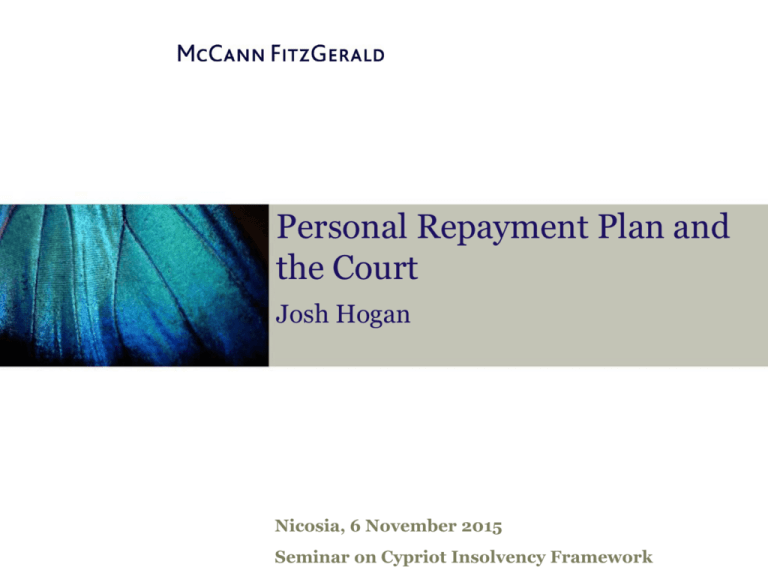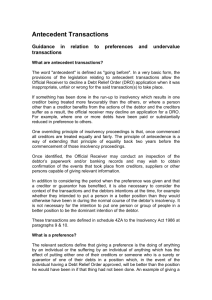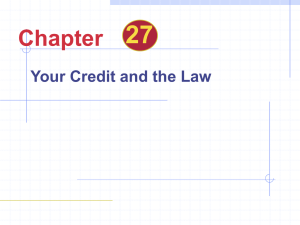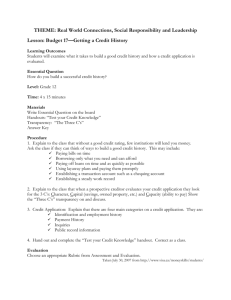Personal Repayment Plan and the Court
advertisement

Personal Repayment Plan and the Court Josh Hogan Nicosia, 6 November 2015 Seminar on Cypriot Insolvency Framework Why Ireland’s experience is relevant Common law jurisdiction with legal system similar to Cyprus Financial crisis resulted in similarly high levels of over-indebtedness and non-performing loans New personal insolvency regime in Ireland operating for 2 years Debt Relief Order and Personal Repayment Plan in Cyprus have many similarities to Debt Relief Notice and Personal Insolvency Arrangement in Ireland Backdrop to insolvency reforms Ireland Cyprus Percentage of loans in 10.4% (Q4 of 2011) arrears 59% ( April 2015) Unemployment 14.3% (Q4 of 2011) 16.3% (July 2015) Bankruptcies in year of new regime 2012: 35 2015: 67 (as of 30 September 2015) Arrears remain a major problem in Ireland Central Bank of Ireland residential mortgage statistics as of end-June 2015: 70,299 principal home loans (9.3%) in arrears over 90 days 26,057 buy-to-let loans (19%) in arrears over 90 days Changing creditor profile due to loan sales: 46,442 mortgage accounts (PDH and BTL) held by non-banks. Of this, 19,539 are in arrears of more than 90 days. New 2015 law enacted to regulate credit servicing firms in Ireland Insolvency reform in Ireland Law Reform Commission comparative legal analysis Little precedent for including secured debt in resolution plans Challenging environment for reform – financial system fragile – high numbers in arrears, widespread negative equity – multiple stakeholder interests – Troika deadlines and assistance Ireland’s reformed personal insolvency regime Personal Insolvency Act 2012 – modernised some elements of bankruptcy – introduced three new procedures as alternatives to bankruptcy – established the Insolvency Service of Ireland – provided for regulation of personal insolvency practitioners (140 now licensed) – created a new category of specialist judge: 6 appointed to deal with debts of up to €2.5 million Insolvency Service of Ireland Overview of the processes IRELAND CYPRUS Bankruptcy 3 years 3 years Debt Relief Order (Debt Relief Notice in Ireland) €35,000 max 3 years 50% surrender of additional assets/income No guarantor relief €25,000 max 1 year No surrender of additional assets/income Guarantor relief Personal Repayment Plan (Personal Insolvency Arrangement in Ireland) €3m cap secured debts 6 years 65% creditor approval or court override No guarantor relief Unlimited debts 5 years 65% creditor approval or court override Guarantor relief Debt Settlement Arrangement (Ireland only) Unsecured debts only 5 years 65% creditor approval No guarantor relief IRL: personal insolvency applications since launch in Q4 2013 England/Wales 2014 Bankruptcies 20,318 Debt Relief Order 26,688 Individual Voluntary Arrangement 52,190 Total 99,196 Benefits of personal insolvency law reform Debtors – physical and mental health, social and economic inclusion, dependants – ‘Fresh start’ (common law countries): "One of the primary purposes of the Bankruptcy Act is to 'relieve the honest debtor from the weight of oppressive indebtedness, and permit him to start afresh free from the obligations and responsibilities consequent upon business misfortunes'. This purpose of the act has been again and again emphasized by the courts as being of public as well as private interest, in that it gives to the honest but unfortunate debtor who surrenders for distribution the property which he owns at the time of bankruptcy a new opportunity in life and a clear field for future effort, unhampered by the pressure and discouragement of pre-existing debt." (Local Loan Co. v Hunt 292 US 244, per Sutherland J (1934)) – ‘Earned start’ (civil law countries) Benefits of personal insolvency law reform Creditors – fair distribution in orderly and rational process – maximise recovery to the extent the means of the debtor reasonably permit (reduce collection costs and avoid depressed asset sales) Economy / society – consumer spending – encourage responsible lending and investment – cost-effective alternative to State spending (e.g. welfare) / tax relief – entrepreneurship (EU Commission A second chance for entrepreneurs) Recent European reforms No established international best practice in personal insolvency law but recent reforms in Europe: – aim to balance social policy considerations (e.g. in relation to principal private residence) with need to maintain payment discipline and avoid moral hazard – introduce statutory workout processes to allow individuals earn a fresh start – recognise importance of unsustainable residential mortgage debt International perspectives World Bank Report on the Treatment of the Insolvency of Natural Persons (Dec 2012) – no recommendations, but useful observations IMF Working Paper Dealing with Private Debt Distress in the Wake of the European Financial Crisis: A Review of the Economics and Legal Toolbox (Feb 2013) – identifies “basic design features” for an economically efficient personal insolvency law IMF-identified design features for reform Allocate risks among parties in a fair and equitable manner Provide a fresh start through discharge of financially responsible individuals from the liabilities at the end of insolvency proceedings (typically after 3-5 years) Establish appropriate filing criteria to make insolvency procedures accessible to individual debtors while minimizing abuse IMF-identified design features for reform Impose automatic and temporary stay on enforcement actions with adequate safeguards for creditor interests Set repayment terms that accurately reflect the debtor’s capacity to repay to ensure an effective fresh start Recognize foreign proceedings and enable crossborder cooperation to avoid bankruptcy tourism PIA / PRP Debtor must be cash-flow insolvent with no likelihood of becoming solvent within 5 years Once in lifetime (IRL), once in 20 years (CY) Flexibility as to terms of arrangement and how debts are treated, subject to mandatory requirements Debtor name on public register Creditor enforcement rights restricted Successful completion: – 100% discharge from unsecured debts – discharge from secured debts “to the extent specified” in arrangement Advantages for debtor of PIA / PRP Fresh start: average write-down under PIA in Q3 2015 was 83.7% (unsecured), 19.7% (secured) Flexible - adapted to specific circumstances of debtor – control over assets / income to be surrendered. No automatic loss of home or assets unlike bankruptcy – no minimum discharge period Statutory protections (e.g. IP advice, allowances for reasonable living expenses) Avoid bankruptcy restrictions (and stigma?) PIA / PRP process 1 2 3 4 5 • Appointment of insolvency practitioner • Protective certificate (70 days Ireland, 95 days Cyprus) • Arrangement negotiation and approval • Implementation and monitoring • Termination / completion Role of Court in PC approval Consider application for protective certificate and accompanying documentation (including certificate from Insolvency Service (“IS”)) Court must be satisfied re – eligibility criteria – other application requirements Court can treat certificate by IS as evidence that eligibility criteria are met and application documentation is in order One PC in 12 months Debtor ineligible for PIA if he/she has been issued PC within previous 12 months Exception where court satisfied debtor’s insolvency due to “exceptional circumstances or other factors which are substantially outside the control of the debtor” and it would be “just” to permit the debtor to propose PIA Extensive use of exception by courts to avoid prejudice to debtors Corresponding exception does not appear to be present in Cypriot legislation – are other mechanisms available to allow some flexibility? Role of court during PC period Court has limited role but may be called upon to: – resolve disputes regarding proof of debts – hear creditor appeal against application of PC to that creditor (irreparable loss?, unfair prejudice to other creditors?) – consider applications for extension (40 days) of protective certificate (debtor and IP acted in good faith and with reasonable expedition?, likelihood of viable proposal?) Secured debt restructuring Case-by-case restructuring of secured debt and security Can delay/avoid crystallisation of negative equity Restructuring might comprise: – Interest-only during arrangement – Extension of maturity – Deferral of payments during arrangement – Change of interest rate or interest basis – Debt for equity swap – Capitalisation of arrears – Principal write-down (with or without clawback) ‘Split mortgage’ popular in Ireland Creditor and debtor protections Creditor protections for ‘economic value’ of security: – if property sold, sale proceeds payable to secured creditor – if property not sold, any principal write-down: cannot, unless secured creditor agrees otherwise, reduce principal below value of security will, unless secured creditor agrees otherwise, be subject to 20 (IRL) / 10 (CY) year clawback where debtor sells property for value greater than the value attributed for purposes of PIA Unless costs ‘disproportionately large’, debtor not required to dispose of interest in, or cease to occupy, primary residence Voting in PIA / PRP General rule: voting rights are proportionate to amount of debt outstanding on day PC was issued Majority by value only of creditors voting not value plus number 3 proportions relevant: ‘No’ votes must not exceed: 35% of ‘total amount’ of debt 50% secured debt 50% unsecured debt Voting in PIA / PRP For voting purposes, value of secured debt is lesser of market value of security or amount of debt on day PC was issued Cypriot law does not distinguish between value of ‘property the subject of security’ and the value of ‘security’. Irish law assumes up to 10% discount on value of property to allow for selling costs etc. Voting in PIA / PRP 50% unsecured vote can include negative equity / sale shortfall portion of secured debt provided such portion abates equally with unsecured debt and will be discharged at end of arrangement No quorum requirement for meeting. Connected creditors can only vote against proposal. Proxy voting common in Ireland Reasons why creditors vote Yes or No YES NO Better return than alternative Bankruptcy alternative not of bankruptcy credible / equally attractive Possibility of uplift where debtor circumstances improve Proposal does not provide realistic return for creditor having regard to debtor circumstances Fair burden-sharing between Loss of control compared to creditors non-statutory restructuring Legal certainty/finality Concerns about moral hazard/strategic default Clawback excessive pension contributions 3rd party servicing / securitisation restrictions on restructuring Role of court in PIA / PRP approval After approval by creditors’ meeting, IP to notify to creditors and IS IS to notify court and furnish copy of arrangement to court (CY: IS to apply to court to ratify arrangement) Where no objection lodged by creditor (CY: or guarantor) within 14 days (IRL) / 21 days (CY) of IP’s notice, court proceeds to consider whether to approve proposal Role of court in PIA / PRP approval Court must be satisfied that – eligibility criteria are met – terms of proposal meet statutory mandatory requirements – terms of proposal do not release excluded debt, excludable debt – requisite majority of creditors approved proposal Court can rely on IP certificates re above Court may hold hearing or request IS to provide information “for the purposes of its arriving at a decision” Other functions of court in PIA / PRP Objection by creditor to coming into effect of DSA/PIA within 14 (IRL) / 21 (CY) days of notice Application by creditor or PIP to court for termination of DSA/PIA – Early termination will lead to full restoration of debts (but not interest during PRP in CY) unless arrangement provides otherwise or court orders otherwise Approval of modifications Excessive pension contribution order Prosecutions / IP regulatory matters Implementation Issues for Irish courts Level of court input greater than initially expected Most IPs are not lawyers, quality of documentation received by courts was frequently inadequate – Improved by IS ‘hand-holding’ on initial applications IS training and circulars on court practice for IPs standardisation of documentation under PIA Protocol court electronic case management PIA Protocol Developed by stakeholders with IS oversight (including extensive IS legal input) UK precedent: Straightforward Consumer IVA Protocol Standard terms and conditions – Reduces time / cost – Improves predictability Commercial terms (e.g. dividends and secured debt restructuring) are specific to each arrangement Creditor and PIP ‘buy-in’ Implementation Issues for Irish courts Frequency of hearings / oral submissions required of IPs in court leads to high additional costs – What is court preference for means of receiving information? – written submissions? – IS to liaise with IPs to obtain missing information / clarifications for court? – hearings? Note - IS in Cyprus can represent debtor in court Implementation Issues for Irish courts New area of law with heightened risk of inconsistent interpretation and application by stakeholders and courts – IS plays important role in identifying issues of general importance, makes legal submissions to court and informs IPs about court decisions (e.g. PIA voting) – Specialist judges with concentration of expertise Implementation issues for Irish courts How to integrate the new personal insolvency regime with existing court processes? – Debtor must try PIA before bankruptcy – Courts can defer bankruptcy applications and repossession proceedings so debtor can consult with IP to consider PIA – Official Assignee in Bankruptcy amalgamated with IS – But: imperfect links with between PIA and bankruptcy, no link with examinership (no equivalent of Cypriot ‘Co-ordinated Repayment Plan’) Implementation issues for Irish courts Court could not override creditor rejections of viable proposals – ‘bank veto’ (i.e. voting power of creditors) criticised – creditors perceived to behave ‘irrationally’ – debtors and PIPs deterred from seeking PIA – €500 PIA application fee waived – €750 payment by IS to IP where viable proposal rejected (42 payments for Q2 2015) – amendments made in 2015 (not yet in force) to provide for non-consensual PIA Non-consensual PIA / PRP Court empowered to impose arrangement on creditors notwithstanding rejection at creditors’ meeting Arrangement must provide for debtor to retain primary residence and (CY only) dispose of all ‘liquid assets’ Restricted eligibility: – Debts must include secured debt over primary residence (€300k cap on value in CY) – CY only: €350k max debts, €250k max assets (excl primary residence) Non-consensual PIA / PRP Time-limited: – CY: debtor is insolvent due to reduction in income of 25% or more since 2009 because of events outside debtor’s control (presumption any reduction between 2012-2015 due to financial crisis) – IRL: debtor was in arrears on primary residence mortgage debt on 1 Jan 2015 (or had restructured the debt to deal with arrears before then) Non-consensual PIA / PRP Approval: – Court must be satisfied as to range of matters, notably: arrangement enables creditors to recover debts due to them, to the extent that means of debtor reasonably permit (IRL) / provides creditors same or better outcome as bankruptcy (CY) IRL: at least one ‘class’ of creditor voted in favour and no unfair prejudice for any interested party (like examinership approval test) More reform? Personal Insolvency Act 2012 amended 4 times already 1 year bankruptcy (currently 3)? – recommended by parliamentary committee after public consultation 3 year income payments order (currently 5)? Personal Repayment Plan and the Court Josh Hogan Nicosia, 6 November 2015 Seminar on Cypriot Insolvency Framework







